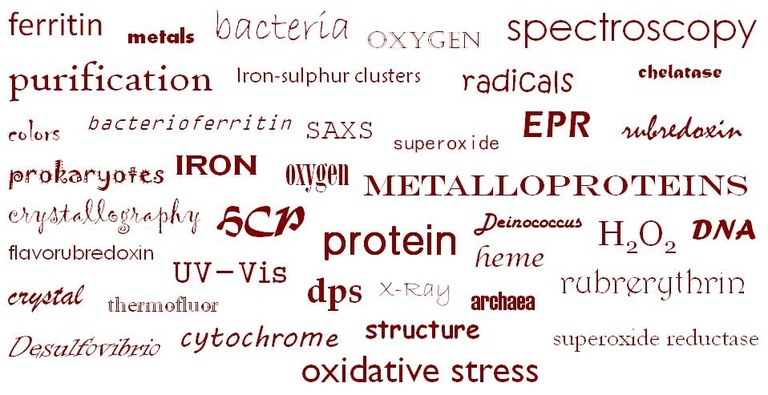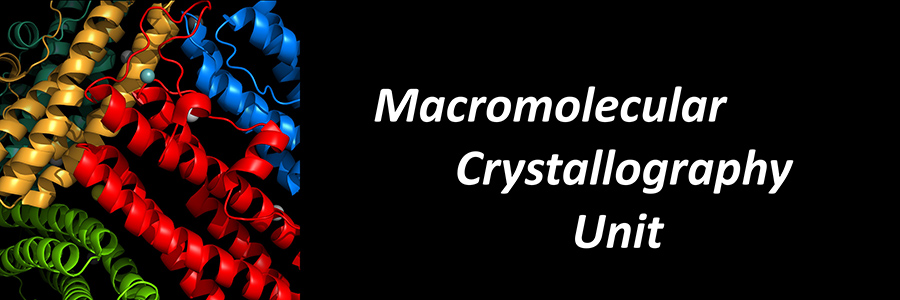Romão Team || Oxidative stress

I am currently interested on the study of oxidative stress response mechanisms in prokaryotes, namely at the level of proteins that are involved in those responses, such as Dps, (DNA-binding proteins from starved cells), proteins involved on DNA protection coupled with iron storage, and rubrerythrins, proteins involved on detoxification of hydrogen peroxide. As part of the collaboration with the two Laboratories to which I belong, I am also involved on the structural determination and analysis of the following enzymes: superoxide reductases (SOR), enzymes responsible for the detoxification of the superoxide anion, that are present in anaerobic and microaerobic organisms (prokaryotes and eukaryotes), and flavodiiron (FDP) proteins, which are NO and/or oxygen reductases. Furthermore, I am also interested on metalloproteins in general, my delight for “proteins with color” starting in the beginning of my scientific career. Over the years I have been involved on the study of different bacterial metalloproteins, which was fundamental to create a special taste and sensibility for their study.
The main goal of my research is to understand the cellular function of the systems that I am studying, through a multidisciplinary approach, using different and complementary techniques and expertises: biochemical, kinetics, biophysical, spectroscopic and structural characterization at high and low resolution.
Team members
Célia Romão, PhD
Bruno Salgueiro, PhD student
André Gouveia, PhD student
Collaborations
Institut de Biologie Structurale (IBS), Grenoble, France.
Publications (2017 - 2023)
-Gouveia AG, Salgueiro BA, Ranmar DO, Antunes WDT, Kirchweger P, Golani O, Wolf SG, Elbaum M, Matias PM, Romão CV. Unraveling the multifaceted resilience of arsenic resistant bacterium Deinococcus indicus. Front Microbiol. 2023 Aug 24;14:1240798. doi: 10.3389/fmicb.2023.1240798.
-Silva LSO, Matias PM, Romão CV, Saraiva LM. Repair of Iron Center Proteins-A Different Class of Hemerythrin-like Proteins. Molecules. 2022 Jun 23;27(13):4051. doi: 10.3390/molecules27134051.
-Amaral C, Vicente CT, Caetano SM, Gaspar-Cordeiro A, Yang Y, Cloetens P, Romão CV, Rodrigues-Pousada C, Pimentel C. An Internal Promoter Drives the Expression of a Truncated Form of CCC1 Capable of Protecting Yeast from Iron Toxicity. Microorganisms. 2021 Jun 20;9(6):1337. doi: 10.3390/microorganisms9061337.
-Silva LSO, Matias PM, Romão CV, Saraiva LM. Structural Basis of RICs Iron Donation for Iron-Sulfur Cluster Biogenesis. Front Microbiol. 2021 Apr 29;12:670681. doi: 10.3389/fmicb.2021.670681.
-Galego L, Barahona S, Romão CV, Arraiano CM. Phosphorylation status of BolA affects its role in transcription and biofilm development. FEBS J. 2021 Feb;288(3):961-979. doi: 10.1111/febs.15447.
- Santos S.P., Yang Y., Rosa M.T.G., Rodrigues M.A.A., Bouthier De La Tour C., Sommer S., Teixeira M., Carrondo M.A., Cloetens P., Abreu I.A., Romão C.V.* (2019) The interplay between Fe and Mn in Deinococcus radiodurans triggers cellular protection during induced paraquat oxidative stress. Scientific Reports.9, 17217 (2019). https://doi.org/10.1038/s41598-019-53140-2
- Martins M.C.#, Romão C.V.#, Folgosa F.#, Borges P.T., Frazão C., Teixeira M.(2019) How superoxide reductases and Flavodiiron Proteins combat oxidative stress in anaerobes FRBM 14, 36-60
https://doi.org/10.1016/j.freeradbiomed.2019.01.051
- Borges P.T, Romão C.V., Saraiva L., Gonçalves V.L., Carrondo M.A., Teixeira M., Frazão C. (2019) Analysis of a new flavodiiron core structural arrangement in Flv1-ΔFlR enzyme from Synechocystis sp. PCC6803, Journal Structural Biology 205, 91-102
https://doi.org/10.1016/j.jsb.2018.11.004
- Romão C. V.*, Matias P.M., Sousa C.M, Pinho F.G., Pinto A.F., Teixeira M., Bandeiras T.M. (2018) Insights into the structures of superoxide reductases from the symbionts Ignicoccus hospitalis and Nanoarchaeum equitans. Biochemistry 57, 5271–5281
https://doi.org/10.1021/acs.biochem.8b00334
- Almadanim M. C., Gonçalves N. M., Rosa M. T. G., Alexandre B. M., Cordeiro A. M, Rodrigues M., Saibo N.J., Soares C. M., Romão C. V., Oliveira M., Abreu I. A. (2018) The rice cold-responsive calcium-dependent protein kinase OsCPK17 is regulated by alternative splicing and post-translational modifications. BBA- Mol Cell Res 1865, 231-246. https://doi.org/10.1016/j.bbamcr.2017.10.010
- Santos S.P., Cuypers M.G., Round A., Finet S., Narayanan T., Mitchell E.P., Romão C.V.* (2017) SAXS structural studies of Dps from Deinococcus radiodurans highlights the conformation of the mobile N-terminal extensions JMB 429, 667-687
http://dx.doi.org/10.1016/j.jmb.2017.01.008
- Lobo S.A.L., Videira M.A.M., Pacheco I., Warren M.J., Teixeira M., Matias P.M., Romão C.V., Saraiva L.M. (2017) Desulfovibrio vulgaris CbiKp cobaltochelatase: evolution of a haem binding protein orchestrated by the incorporation of two histidine residues Environmental Microbiology 19, 106-118
